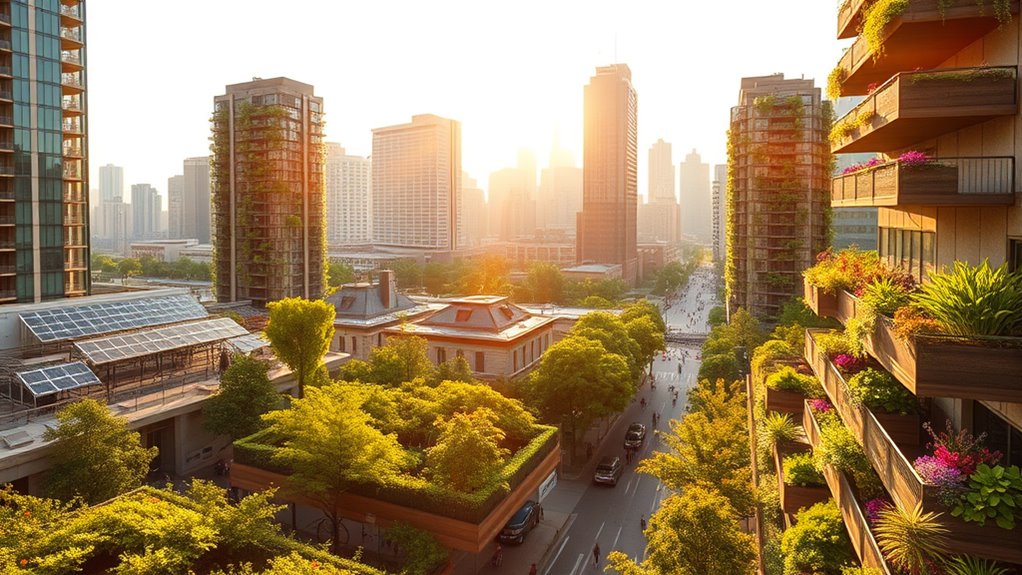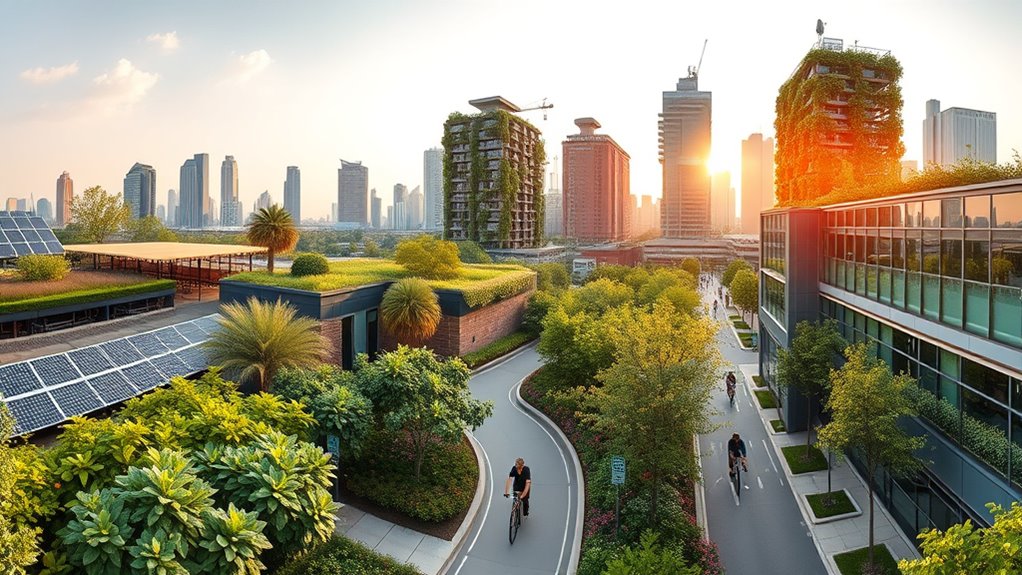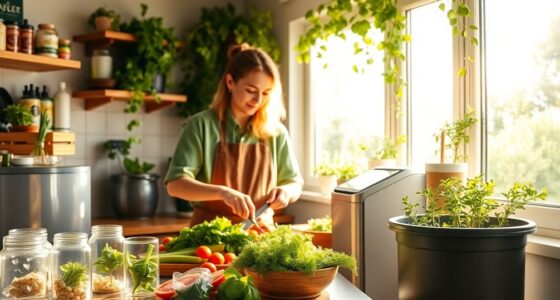Urban areas are embracing sustainable living through practices like urban agriculture, renewable energy, and green building methods that cut emissions and save resources. You’ll see rooftop gardens, solar panels, green roofs, and eco-friendly infrastructure transforming cities into healthier places to live. These innovations promote community involvement, reduce pollution, and boost resilience against climate change. Keep exploring how these efforts are shaping the future of greener, more sustainable cities you can be part of.
Key Takeaways
- Urban agriculture transforms city spaces into green areas, promoting local food production and community engagement.
- Renewable energy infrastructure, like solar panels and wind turbines, reduces urban carbon emissions.
- Green building materials, such as green roofs and rainwater harvesting, improve energy efficiency and urban resilience.
- Community involvement and sustainable practices in daily life foster a culture of eco-conscious urban living.
- Integrating multiple strategies creates holistic, healthier, and more resilient cities for a sustainable future.

Have you ever wondered what makes a city truly sustainable? It’s a complex question, but at its core, it involves how urban areas integrate eco-friendly practices into everyday life. One of the most exciting trends shaping green cities today is the rise of urban agriculture. Instead of relying solely on distant farms, city dwellers are transforming rooftops, vacant lots, and even building facades into productive green spaces. These initiatives not only reduce the carbon footprint associated with transporting food but also bring fresh produce directly to residents, promoting healthier lifestyles. Urban agriculture also fosters a sense of community, as neighbors come together to tend gardens and share the bounty. It’s an innovative way to make cities more self-sufficient and resilient, especially in the face of climate change and resource scarcity.
Urban agriculture transforms rooftops and vacant lots into green spaces, boosting community, sustainability, and resilience in cities.
But urban agriculture is just one piece of the puzzle. To truly embrace sustainability, cities are investing heavily in renewable infrastructure. This means replacing traditional energy sources with solar, wind, and other renewable options, reducing reliance on fossil fuels that pollute the environment. Think of solar panels lining rooftops, wind turbines in city outskirts, and smart grids that efficiently distribute clean energy. These efforts are essential because they lower greenhouse gas emissions and help cities meet ambitious climate targets. Plus, renewable infrastructure often leads to economic benefits, creating jobs and reducing energy costs over time. You might notice these changes in your daily life — from quieter, cleaner streets to more stable energy supplies, all thanks to the shift toward sustainable infrastructure. Incorporating renewable infrastructure is a crucial step toward creating truly sustainable urban environments.
Cities also incorporate green building materials and practices, further reinforcing their commitment to sustainability. Green roofs, for example, insulate buildings, reduce heat islands, and absorb rainwater, lessening the strain on urban drainage systems. Water conservation measures, such as rainwater harvesting, supplement the city’s water supply and reduce waste. These initiatives work together to create a more balanced ecosystem within the urban environment. As a resident, you have a role in supporting these efforts — whether by choosing energy-efficient appliances, participating in community gardens, or advocating for green policies.
Ultimately, the key to a truly sustainable city is a holistic approach that combines urban agriculture, renewable infrastructure, and innovative green practices. When you see these elements working together, it becomes clear that green cities are not just about planting trees but transforming urban spaces into healthier, more resilient places to live. You’re part of this movement, and your everyday choices can contribute to a greener, more sustainable future for the city.
Frequently Asked Questions
How Do Green Cities Impact Local Economies?
Green cities boost your local economy by driving economic growth and creating jobs. As these cities invest in sustainable infrastructure, renewable energy, and green technology, they attract new businesses and tourism. You’ll see more employment opportunities in eco-friendly sectors, which benefits residents and vendors alike. Plus, sustainable initiatives often reduce costs, allowing funds to be reinvested into the community, fostering overall economic resilience and prosperity in your urban area.
What Are the Biggest Challenges in Implementing Sustainable Urban Projects?
You face challenges like funding and political support when implementing sustainable urban projects. Urban green infrastructure requires significant investment, and integrating renewable energy can be complex due to existing infrastructure and regulations. You also need to navigate community acceptance and coordinate multiple stakeholders. Overcoming these hurdles demands strategic planning, policy support, and public engagement to make certain of successful adoption of green initiatives in your city.
How Do Green Initiatives Affect Housing Affordability?
Imagine a city as a garden, where green initiatives are the sunlight and water. These efforts lower energy costs and boost property values, making neighborhoods more attractive. However, as the garden flourishes, housing affordability can struggle, since higher property values may price out some residents. You might find that sustainable living benefits the community overall, but it can also create barriers for those seeking affordable homes.
What Role Do Citizens Play in Sustainable City Planning?
You play a vital role in sustainable city planning through citizen participation and community engagement. By voicing your ideas, attending public meetings, and collaborating with local officials, you help shape policies that promote green initiatives. Your involvement guarantees that development projects reflect community needs and environmental goals. Active participation empowers you to influence decisions, foster transparency, and create a more sustainable, livable city for everyone.
Are Green City Strategies Adaptable to Different Climate Zones?
Yes, green city strategies are adaptable to different climate zones. You can implement climate-specific strategies tailored to your region, like drought-resistant landscaping in arid areas or urban cooling techniques in hot climates. Regional adaptation techniques help optimize sustainability efforts, ensuring they suit local weather patterns and resources. By customizing approaches, you make your city more resilient and environmentally friendly, regardless of the climate zone.
Conclusion
As you see, green cities are transforming urban living by prioritizing sustainability. Imagine walking through a city where rooftops are covered in gardens, like Milan’s Bosco Verticale, reducing heat and improving air quality. These efforts show that small steps, like implementing bike lanes or solar panels, can make a big difference. By embracing eco-friendly practices, you contribute to a healthier planet and a more vibrant, resilient community. The future of urban living is green—and it’s within your reach.









